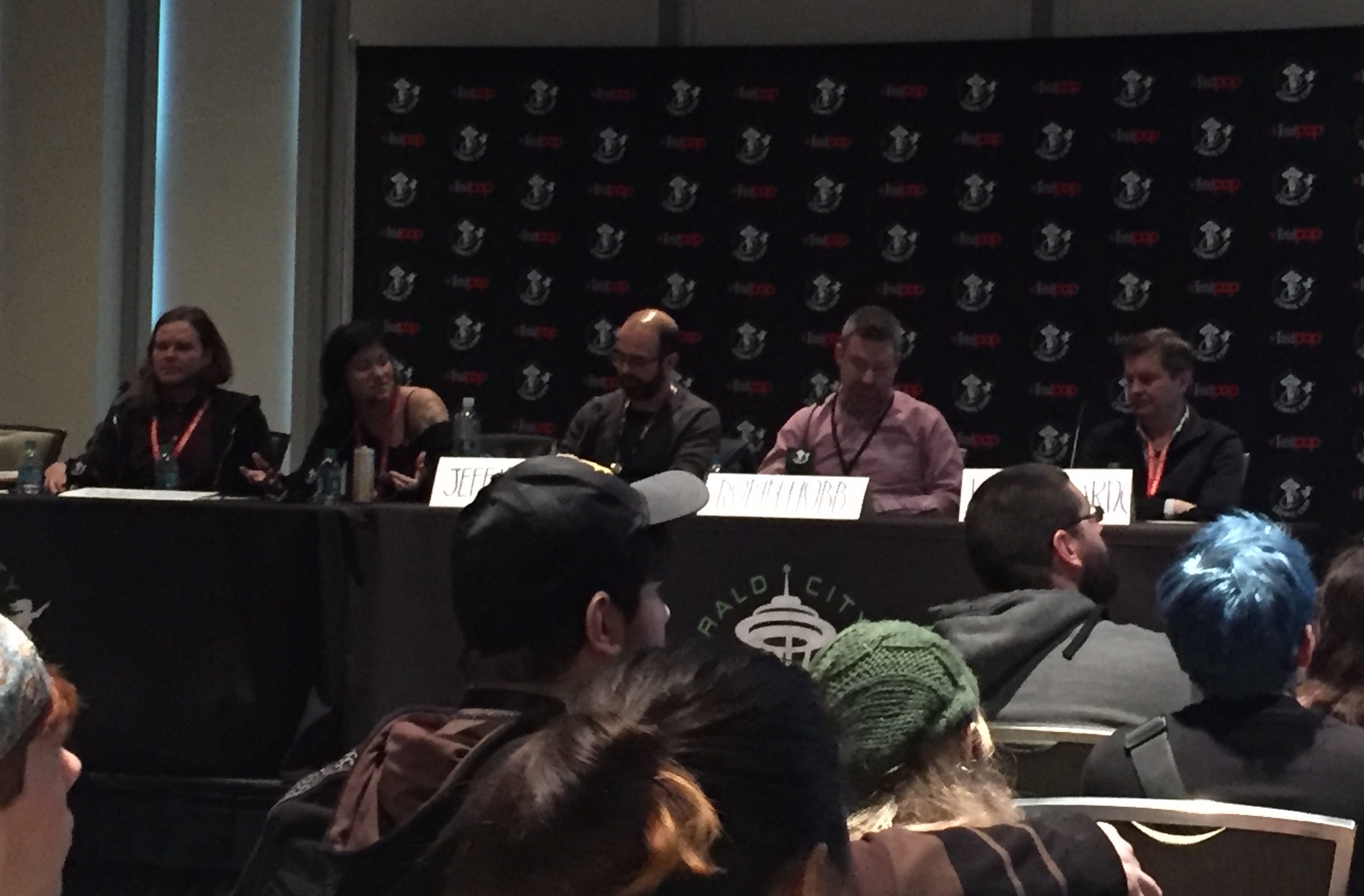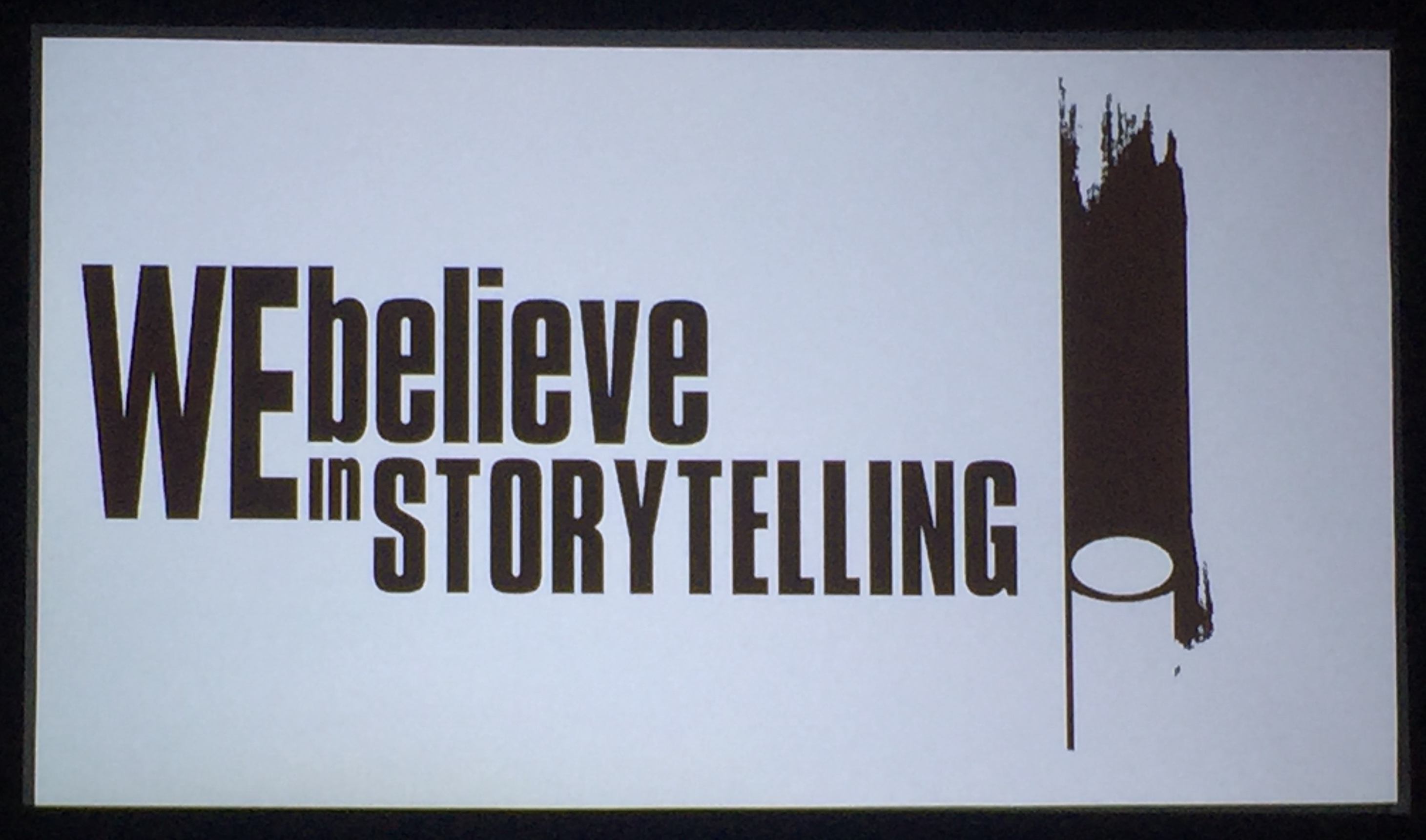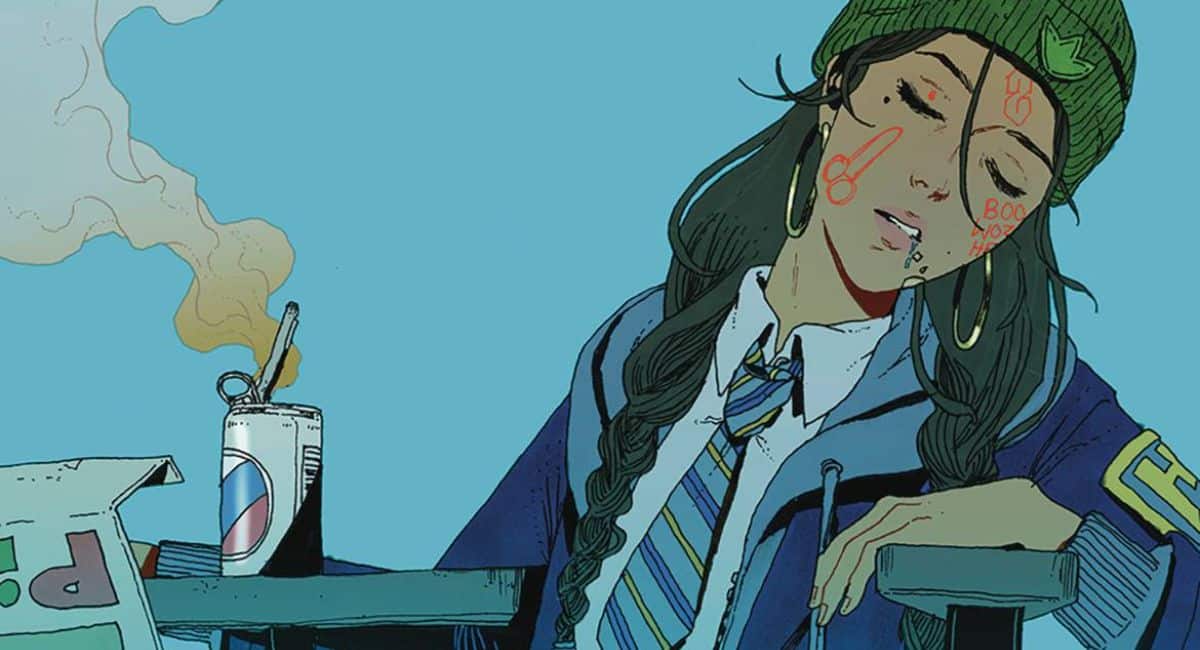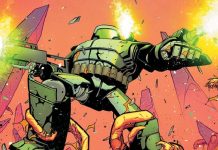
By Joe Grunenwald
Earlier this year, Image Comics announced #WeBelieve, a campaign that they promoted as “highlighting the important, lately overlooked components of the comics industry.” With a panel on each of ECCC’s four days this year, Image took an hour each day to focus on one such component. The first three days’ panels focused on Vision, Imagination, and Creativity, and their final panel of the con, “Image Comics: We Believe in Storytelling,” was a lively, often hilarious discussion featuring creators Charles Soule (Curse Words), Tini Howard (Hack/Slash: Resurrection), Jim Zub (Wayward), Jacob Semah (No. 1 With A Bullet), and Farel Dalrymple (Proxima Centauri).
After brief introductions from the panel’s moderator, Howard spoke about the first arc of Hack/Slash: Resurrection, in which Cassie goes to summer camp to solve some mysteries. She said that the recently announced issue 7 is a single-issue story, and the first trade collection is out in late April. She described the series as being about the aging process and what it feels like to get older. Cassie Hack feels like she’s done, Howard said, and has to figure out how to keep going in spite of that. Celor and K. Michael Russell provide the art for the series.

As an introduction to Curse Words, Soule asked everyone to imagine if a wizard popped up in Central Park. The series centers on such a wizard named Wizord, Soule said, who turns out to be an evil scumbag who was sent to Earth to destroy the world, but who changed his mind when he arrived. Eventually his boss starts sending other evil wizards to destroy both Wizord and the Earth. Entering its second year, Curse Words features art by Ryan Browne, about whom Soule deadpanned that, while Browne’s previous series, God Hates Astronauts, is not as good as Curse Words, it is still very good. He also said, without offense to the others on the panel, that Curse Words is superb. The series includes a talking koala as Wizord’s sidekick, as well as a hidden baseball theme running throughout the book, which he added for Browne because the artist likes baseball. Soule says he puts these things in and gets them wrong every time to mess with Browne (whether he gets them wrong is on purpose or not was not clear). The latest issue of the series will introduce The Overlander, who is based extremely loosely on former Detroit Tigers pitcher Justin Verlander.
Volume 2 of Zub and artist Jim Morissette’s Glitterbomb was just released last week. In another story that sounds not unlike current events, the series follows Farrah, a middle-aged actress whose life was ruined by the elite of Hollywood and who goes on a revenge spree. Zub said that each arc of the story will follow a different main character, though the characters will be connected. The second volume of the series, “The Fame Game,” follows a character who is both connected to Farrah and given the opportunity to follow in her footsteps. Zub next talked about Wayward, his series with artist Steven Cummings, which Zub described initially as “Buffy in Japan.” Volume 5 of the series was just released, and continues expanding the world of the series. Soule called Wayward his favorite of Zub’s projects, particularly in regards to the amount of research that goes into putting the book together. Zub said that he has “a monster scholar” who has assisted with research into the mythology of different cultures. All of the characters have been through a trauma, Zub said, and their powers are tied to their reactions to that trauma. He described the series as exploring the idea of superpowers but grounding it in cultural themes.
Farel Dalrymple’s Proxima Centauri was just announced a few weeks ago at Image Expo, and is set in the same universe as Dalrymple’s graphic novel, The Wrenchies. It focuses on one character from the graphic novel exploring different parts of a space station and trying to get back to Earth. He described the series as an action comic but with teen angst and psychedelic space opera mixed in. When asked why he chose to set the series in space, he jokingly said he did it out of boredom, as most of his previous material has been based in a terrestrial setting.
Semahn and Howard were asked how they mix elements of the fantastic with the characterization and themes of their books. Howard said that it comes from wanting to draw reactive emotions from her characters, so she puts them in crazy situations to see how they react. Including fantastic elements can make otherwise mundane situations more entertaining, Howard explained, while also requiring the book to walk the line between the fantastic and the relatable. In working on No. 1 With A Bullet, Semahn said that “the horror of this book wasn’t really hard.” He said that he uses the book as a way to vent his frustration at all of the ‘advancements’ that humans have created for themselves, like social media and hacking. People online seem to forget about the people on the other end of ‘send’ button, Semahn said, and he wanted to explore that in the series. Semahn expressed relief and sadness about how no one working on the book had ever been targeted for harassment. Each issue of the series includes back matter that covers women in entertainment and harassment, including how there is very little protection for people on the internet from harassment. Howard provided an essay on her experience with a stalker for the back matter of the series’ first issue.
Zub and Soule were asked about developing magical worlds and how to ground stories in these worlds where anything can happen. Soule described the built-in limitations he has set for the characters in Curse Words on a power level, but also the emotional challenges that the characters still face regardless of their incredible powers. Zub said that there are a lot of supernatural elements in Wayward, but that most of the powers of the main characters, all of whom are teenagers, are tied to their emotions. He also said that everything the characters do has consequences and comes back to haunt them, and that the fact that they’re teenagers means they don’t always think about what those consequences are going to be before they do things.
Howard and Dalrymple were asked about the distinctive voice of their work and how they hold onto that even after having been writing comics for so long. Dalrymple cited movies like Over The Edge and novels like Robert Cormier’s The Chocolate War as being big influences on him, and said that he may be in a certain state of arrested development, saying that an ex-girlfriend once called him a man-baby. Howard concurred that, even though she’s a functioning adult, she still feels young and does young things, though she admitted that what people may read in her work as youth may actually be insecurity about being an adult. She also described the fact that she has managed to build herself a life in which she can do adult things while still enjoying the things she loved as a child.
When asked about what the panelists wish they had known when they were just starting out in regards to pitching comics, Zub said that people need to tell a story that’s important to them and not what the market is doing. He cited The Walking Dead, Bone, Saga, and Scott Pilgrim as good examples of books that were very unique when they first came out and that became huge hits by doing their own thing. They were created out of love and not as a way to try to capitalize on trends that were popular at the time. Howard said that it’s okay to write non-linearly and not to worry about things in a script being bad because you have to get the ideas down before you can polish them and make them good. She cited George R.R. Martin as someone she enjoys listening to talk about writing because his books are so rich and full of ideas that could be their own separate stories. Zub concurred that first drafts are never perfect, while also stressing the importance of the collaborative nature of comics, and that the best work comes out of that process between writers and artists. Semahn said, in relation to pitching, to start small with a tight outline for a short story and a good ending. Soule agreed with the other panelists and jokingly (?) accused them of stealing his ideas. He said that stories ultimately need to be about something beyond the plot of the story. For Curse Words, Soule said that the comic is actually about goodness and how to be good. Zub further said that there has to be a reason for a writer to write something beyond just writing something. He called his past series Skullkickers a love letter to the things that he loved as a kid. Howard made the point that, plot-wise, both she and Zub’s books are about girls fighting monsters, but that the story reasons for the girls fighting monsters are completely different. Zub also said that finishing things is incredibly important, He described a friend who worked for years on a series without writing an actual draft, and who, once he did complete a draft, wouldn’t admit that it was actually a draft, calling it a “pre-draft.” He then joked that that’s like a penis entering a vagina but the person saying they still hadn’t had sex, which drew a huge laugh from the audience and panelists, and it was pointed out that there was a small child in the front row.
With time left for just one question, an audience member asked how the writers balance their time between doing creative things and their other responsibilities. Howard described herself as “a spoiled housecat” who writes full-time, but said that it took time to find that balance between working and spending time with her significant other. She said that she’s always thinking about stories even when she’s doing other things, and described an analogy that Matt Fraction once made about writers’ brains being like crockpots. Semahn said that, at a time when he was working 12-hour days, he turned to Steven T. Seagle from Man of Action for advice about how to find time to write. Seagle suggested waking up 15 or 20 minutes earlier each day to devote to writing, and after a few weeks to look at what he’d done. He stressed that simply making the time to write was the most important thing.
Zub writes half-a-dozen comics each month and is also a tenured professor at Seneca College in Toronto. He described his daily schedule as teaching during the day, and after work going home and having dinner with his family, then writing until midnight. He said writing should be a habit that’s made a priority. Soule joked that he’s writing 40 titles a month but that he employs a staff of 15 to 20 ghost-writers who help him meet his deadlines. With laughter and a round of applause from the audience, the panel ended.







Comments are closed.